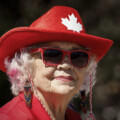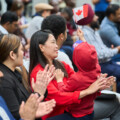Halfway through 2025’s spin around the sun, it has been another year of surprises for most Canadians. I’m not sure when we returned to normal post-pandemic, or if we ever did. The pot of crises north and south of the border is in a state of constant oscillation from simmer to rolling boil, seemingly never cool to the touch.
In need of a pleasant surprise and at a time of heightened civic pride, Canadians found a moment to rejoice during February’s 4 Nations Face-Off in an NHL mid-season tournament where Canada reasserted its hockey supremacy. Canada’s thrilling overtime victory against the U.S. team amidst bilateral tensions was a surprisingly inspiring moment for a country in need of one.
A few months later, Canadian 4 Nations overtime hero, Connor McDavid, brought the Edmonton Oilers back to a second consecutive Stanley Cup Final against familiar foe the Florida Panthers, led by American 4 Nations antagonist, Matthew Tkachuk. There was a similar sense of national attention in this match-up, but if you ask rival Calgary Flames supporters or perennially disappointed Toronto Maple Leafs loyalists (like myself), the moment didn’t quite feel quite as patriotic.
Alas, the Oilers came up short against the now back-to-back Stanley Cup champion Panthers. It was at this moment that Canadian sports fans were ready to shut it down for the summer. Aside from pockets of NHL and NBA free agency news and regional CFL support, the sports calendar usually takes a pause at the start of July.
But this year, one more surprise was offered up for Canadian sports fans. Enter the Toronto Blue Jays.
No better time for a hot streak
It’s about this time of year that the casual Canadian sports observer checks in on the Blue Jays for the first time to see what kind of start they’ve gotten off to. For the past few seasons, the question has been: Is the final wildcard playoff spot still within reach? But this summer, something special happened.
On June 30th, the Jays were three games behind the New York Yankees for first place in the American League East division. As fortune would have it, the Jays were opening a four-game series against the Yankees that day. They could not have picked a better time to get hot.
The Blue Jays went on to sweep the Yankees, winning all four games, including on Canada Day, while donning their ceremonially Canadian red and white uniforms. The Blue Jays jockeyed ahead of the Yankees for the division lead and haven’t looked back, following that up with a three-game sweep of the Los Angeles Angels, taking two of three from the Chicago White Sox, and, as we leave the mid-season break for the All-Star Game, winning one of three against the relocating Athletics.
Expectations were low for the Blue Jays at the start of the season, after missing the playoffs entirely last year. Apathy was setting in on a team and management regime that hasn’t won a single postseason game since 2016. Yet, they picked exactly the right time to remind us, in a country where hockey reigns supreme, that the Toronto Blue Jays have carved out a unique and enduring place in Canadian culture.
Blue Jays baseball is distinctly Canadian
The nostalgia of the Blue Jays can mean different things to different generations. The early 1990s represent a golden era for the Blue Jays and hold deep emotional resonance for those who experienced it. The back-to-back World Series championships in 1992 and 1993 were cultural milestones. While we claim the Stanley Cup as ours (despite a Canadian team not winning it since 1993), it was the first time a major North American sports trophy headed north of the border in the modern era. Joe Carter’s iconic series-ending walk-off home run remains one of the most replayed and beloved moments in Canadian sports history.
To some Canadians, baseball nostalgia runs even deeper than the Blue Jays; some of the game’s most important moments happened in Canada.
The first recorded baseball game in North America is believed to have taken place in Beachville, Ontario, in 1838, laying early claim to the sport’s origins. By the early 20th century, Canada had become a key destination in baseball’s development. Babe Ruth famously hit his first professional home run in Toronto in 1914 while playing for the Providence Grays at Hanlan’s Point Stadium. Decades later, Jackie Robinson broke the minor league colour barrier in Canada, playing for the Montreal Royals in 1946—a year before joining the Brooklyn Dodgers. These moments, along with the establishment of the Montreal Expos in 1969 and the Toronto Blue Jays in 1977, solidified Canada’s enduring connection to baseball’s lore.
From their inception in 1977 to their World Series triumphs in the early 1990s and into their current era of renewed hope, the Blue Jays have been a cultural touchstone for generations of Canadians.
Unlike other American professional sports franchises, the Blue Jays are distinct in their national reach. Since the departure of the Montreal Expos, the Blue Jays have been Canada’s national baseball team. Their games are broadcast coast-to-coast-to-coast with a fan base that stretches from Newfoundland to British Columbia and up to the Arctic Ocean, making them a unifying force in this country defined by regions stretched out across its vast geography.
This national appeal was nowhere more evident than during the playoff runs of 2015 and 2016. Canadian flags were draped across outfield seats at the Rogers Centre, Jose Bautista’s bat flip was viewed in living rooms and basements across the country, and I feel confident in saying it has been imitated on every single community diamond since. Even casual fans were drawn in by the buzz, reinforcing the Blue Jays’ role as one of the few sporting entities capable of uniting Canada under a single banner.
The Blue Jays are Canada’s summer team
Back to here and now, the Blue Jays are one of the most culturally significant teams in Canada. When I attend games with my young children, we are routinely sitting next to families who have travelled from across the country to attend a game in the shadow of the CN Tower. Watch a game on television as the Blue Jays travel to Seattle, Minneapolis or Detroit, and you will see more blue caps in the crowd than you will of the home team, as fans from British Columbia, Manitoba and Ontario descend south of the border to cheer on their national team.
Ten provinces and three territories make up a market vaster than any regional U.S. market. It’s a market that stretches beyond the Greater Toronto Area, Ontario, or Central Canada.
As we exit the MLB’s All-Star break, the Toronto Blue Jays sit atop their division, with 66 games left on the schedule to cement their spot there. These games will have higher stakes than in recent years and will be watched and listened to on boats anchored off Port Renfrew, British Columbia, in tents pitched near Bow Valley, Alberta, at backyard barbecues in Thunder Bay, Ontario, inside RVs rolling along the Cabot Trail in Cape Breton, Nova Scotia, and everywhere else in between.
Here’s to hoping the Toronto Blue Jays organization continues its tradition of uniting a nation and the generations within it with a surprising divisional pennant.
The Toronto Blue Jays are Canada’s summer team.








